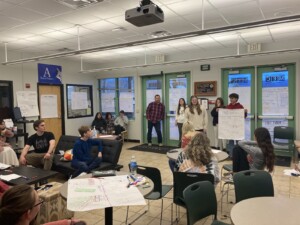Student Surveys: Why They Matter and 5 Key Design Principles of Great Surveys

Zoe Mercer-Golden
Great teaching makes a huge difference in the lives of students. But it can be challenging to understand how students view their learning environments and their teachers, and to provide actionable feedback to teachers. Let’s look at why student surveys can be a valuable source of feedback for educators, schools, and districts, and why it’s important to use an instrument that will collect high-quality data. We’ll end by explaining why measuring five core topics can be high-leverage for schools and districts who want to improve teaching effectiveness and student outcomes.
Why use student surveys to measure teaching effectiveness?
In 2012, the Bill and Melinda Gates Foundation Foundation released the findings of the three-year Measures of Effective Teaching (MET) Project, which found that student perception surveys were one valid way to measure teaching effectiveness. Since then, millions of students have taken surveys about their classroom experiences in order to give their teachers in-depth feedback about their practices. Student surveys are regularly used by districts around the country to set goals and support strategic planning at the classroom-, school-, and district-level.
Why use a research-validated instrument?
When using perception data to provide educators with feedback or to chart progress against a strategic plan, it’s important to have confidence in the quality of the data collected. Because we know that what gets measured gets improved, it’s essential to use an instrument that conforms to research and survey design best practices and features high validity and reliability.
While there are many important topics to consider when measuring teaching effectiveness, there are five core topics that are particularly important: Pedagogical Effectiveness, Rigorous Expectations, Classroom Climate, Student Engagement, and Teacher-Student Relationships.
1. Pedagogical Effectiveness
Students taught by educators with highly effective teaching practices are more likely to be engaged in the classroom, achieve better grades, and have higher test scores. By measuring pedagogical effectiveness, schools and districts can learn about how much students are learning from a teacher about a particular subject area, how well teachers manage student behavior in the classroom, and how well teachers engage students who may have different learning styles or needs. Scores for a particular teacher on pedagogical effectiveness are likely to predict the achievement gains his or her students make in the academic subject that teacher teaches, as well as how well students are being prepared for college and career.
Example Questions:
- How interesting does this teacher make what you are learning in class?
- How good is this teacher at teaching in the way that you personally learn best?
2. Rigorous Expectations
Students who feel that they are being held to high standards around effort and understanding by their teachers are more likely to trust that their teachers believe in them and their capacity to succeed, and as a result, achieve greater academic success. Measuring students’ perceptions of their teachers’ rigorous expectations allows schools and districts to learn whether students feel their teachers encourage them to do their best work and hold them to high standards around performance, effort, and persistence in class. Results for a particular teacher or from a particular group of students on rigorous expectations are likely to predict student academic performance, as well as college and career readiness.
Example Questions:
- How much does this teacher encourage you to do your best?
- How often does this teacher make you explain your answers?
3. Classroom Climate
When students feel secure in their classroom and school, they are better able to engage in learning. Student perceptions of their classroom climate measure how safe, comfortable, and secure students feel, physically and emotionally, in their classroom. Student responses on the classroom climate scale should predict improved academic outcomes, as well as reduced incidents of disciplinary action, including suspensions and expulsions.
Example Questions:
- How fair or unfair are the rules for the students in this class?
- In this class, how much does the behavior of other students hurt or help your learning?
4. Student Engagement
Engaged students are more likely to achieve a high level of academic success, attend class regularly, and stay in school. Schools and districts can learn about student engagement by measuring how invested and attentive students are in their classes. Student scores about engagement are likely to predict student academic performance in the particular class and subject area, especially student grades and test scores. Scores on classroom engagement are likely to be correlated with how likely students are to attend class and complete their education.
Example Questions:
- How excited are you about going to this class?
- In this class, how eager are you to participate?
5. Teacher-Student Relationships
Students who feel connected to their teachers and to other school adults tend to perform better academically and have better behavioral records in individual classes and in school in general.
Because strong teacher-student relationships are an important indicator of many different kinds of student outcomes—academic, professional, and social—teacher-student relationships can be used to determine how much students feel a sense of belonging in school, as well as how likely a student is to drop out of school. Scores on the questions on this topic may also be correlated to how much students value particular subjects and their probable academic success in a subject.
Example Questions:
- How respectful is this teacher towards you?
- How excited would you be to have this teacher again?
To measure these five critical topics and others, we developed the Panorama Student Survey. The survey was designed in line with survey design best practices, and features nineteen topics that measure important aspects of teaching and learning. Because schools and districts have different needs depending on their context, the survey allows educators to customize what they measure by choosing what topics matter most to their community.
Student surveys can play an essential role in improving teaching effectiveness by providing educators, schools, and districts with high-quality, actionable feedback, while also helping schools and districts predict and improve student outcomes. Fundamentally, student surveys can help educators see inside students’ heads– and take action from there.
For more check out:
- Instructional Leadership through Focused Observation and Feedback
- “Moneyballing” Grades: Using Sabermetrics to Improve Feedback
- Instructional Leadership through Focused Observation and Feedback
Zoe Mercer-Golden is a Marketing Manager at Panorama Education. Follow us Panorama Education on Twitter, @PanoramaEd.
Stay in-the-know with all things EdTech and innovations in learning by signing up to receive the weekly Smart Update.




0 Comments
Leave a Comment
Your email address will not be published. All fields are required.